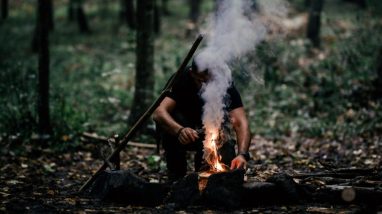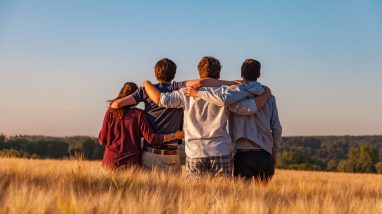The Art of Building the Perfect Campfire
For millennia, campfires have been used as a source of warmth, protection and for cooking food. A quintessential part of any camping trip, the ritual of building a fire brings people together, whether you’re gathering wood, roasting sausages or marshmallows, or simply enjoying the warmth and glow.
Building a campfire will keep your campsite cozy on cool evenings and allow you to prepare hot meals, creating a communal space for relaxing, singing songs and sharing stories. But it’s more than just taking a match to a pile of wood – creating a campfire requires patience, dry supplies and a little practice. Every intrepid camper should know how to make a campfire and be aware of fire safety.
Before you make a fire at your campsite, you should check if there are campsite or local regulations that prohibit it, especially during the summer months when bushfires are a risk. Next thing to think of is that, if you want to make a campfire to boil water or grill a freshly-caught fish, you will need cookware that can withstand an open flame. When the fire has died down and you’re ready for bed, you’ll need to make sure the last person by the fire puts it out completely. And when you leave, you should erase all traces of your fire, insofar as possible. While a crackling campfire creates a comforting atmosphere when you’re camping in nature, you should always leave a campsite in the same way you would like to find it.
Follow Our Step-By-Step Guide to Learn How to Make a Fire and Leave No Trace
Whether you’re making popcorn, pizza or paella, every meal tastes amazing cooked over the fire and every open-air evening is enhanced by a campfire atmosphere. Our guide will show you how to build a campfire safely, whether you’re camping in the forest, mountains, or by the sea.
Pick a good location
The site of your campfire should be at least five metres from your tent, vehicle and any surrounding trees. Try to build a fire in a pre-existing spot, such as a designated fire ring surrounded by stones. If you’re allowed to make your own fire pit, dig a hole around 10cm deep on bare earth and create a border of large stones to prevent the fire from spreading. Always clear the ground around the site and keep an eye out for overhanging branches.
Collect dry tinder and kindling
To get the fire started, you will need fuel. Collecting tinder, kindling and firewood can be a fun activity to do with kids. Take a walk around your campsite and look for dry grass, pine needles and twigs the size of a pencil. Larger pieces of firewood should not be thicker than your wrist. It is a good idea to collect firewood before it gets too dark and make a pile to last the evening. If you are camping by a lake or the sea, dry driftwood can also be used.
Get it started
There are countless ways to construct a campfire, but basically, you should pile quick-burning tinder in the centre and construct a cone-shaped tee-pee of kindling around it, allowing enough oxygen to enter and fan the flames. Light the tinder. While commercial firelighters will get the fire started faster, if you were organized enough to bring some, dry pinecones are an excellent alternative. Once you hear the fire crackling, it means the tinder is burning and you can gradually add more wood, starting with smaller pieces.
Making a campfire in wet conditions
Nothing feels better than the warmth of a campfire on a rainy day. Although conditions may be tricky, there are a few ways to get a fire roaring. Use dead twigs from pine, fir and spruce trees, which are more flammable. Strip wet bark from larger sticks or split them in half to reveal dry wood. Start with as much dry tinder as possible, build a tall cone of twigs and light the fire from the base on the windward side.
What to do when it’s windy
A lean-to fire is a smart option if conditions are windy. Position a large piece of firewood perpendicular to the direction the wind is coming from and place your tinder on the downwind side. Lean twigs and branches against the log from small to large. Continuously feed the fire using your stack of foraged firewood and keep an eye out for sparks and embers on windy evenings.
Cooking over a campfire

If you plan to cook over the fire, you will need to wait until the coals get hot enough. Don’t add all the wood at once – your fire may get too big, too smoky, or simply suffocate and splutter out. To avoid burning your food, allow the flames to die down first. You can start grilling when the embers are glowing red. Purchase a grill grate designed to sit over the fire, creating a stable surface for grilling directly or placing a cast iron pan. Bring heat-resistant utensils such as tongs, as well as grill gloves.
Fire safety
You should never leave a campfire unattended, as the risks can be high if campers are careless. Neglect can lead to destructive fires that decimate forests, kill native animals and destroy habitats. A forgotten campfire can also rage out of control, damaging property and endangering local communities. Don’t burn your trash or food waste in the fire and keep a bucket of water nearby in case of emergency.
Fully extinguish your fire
Putting out a campfire safely can take around 20 minutes. If the flames haven’t died down, soak the fire with water to put it out. Take a long stick and stir the embers, unearthing any coals that are still glowing. Pour more water over the fire to extinguish it completely and check that there is no residual heat by holding your hand over the site. Scatter the ashes and cover the site with leaves. If you have done a good job, it will be hard to detect that you have built a fire recently.
Your Campfire Checklist
Once you’ve settled in at your campsite, nothing beats building a fire and staring into its mesmerising depths, but there are a few things to keep in mind.
Be prepared
To get your campfire started, you will need flame and fuel. Waterproof matches and commercial firelighters, that will burn for longer and help the kindling catch on fire, are your friends here. A sharp axe is also a useful tool for splitting foraged wood into smaller pieces. Organic materials from home to use as tinder, such as newspaper, cardboard or dryer lint, will also be very handy.
Forage for firewood without making an impact
When collecting firewood, keep in mind that high-use camping areas can quickly become barren. Gather dry kindling and wood from a wide area away from your campsite. Instead of cutting or breaking branches from living trees that won’t burn well, collect dead or fallen twigs from the ground. Fallen wood burns easily and leaves less impact.
Cooking over a campfire
There’s something unique about the flavour of food cooked on an open fire. Start your day with omelettes, toast and camp coffee, and enjoy baked potatoes and grilled sausages for dinner. If you’re planning to make meals over a campfire, bring durable cookware, such as a seasoned cast-iron skillet and a grill grate. Stainless steel tongs and a long-handled spoon are also useful. Experienced campfire cooks may also use a tripod or churrasco sword to create delicious meals.
Safety first
Always stay by your fire while it is burning and keep it contained within the designated area. Never leave your campsite without ensuring that your fire has been completely put out, as an unattended fire can cause unimaginable damage to the environment. If you’re travelling with children, teach them not to run around too close or play with burning sticks, and make sure they know the fire safety technique of stop, drop and roll.
Relax by the fire

Once you have mastered the art of building a fire, you can finally sit down with a drink and watch the dancing flames. Campfires seem to awaken a primal feeling in people, making us think about the basic needs of our ancestors. A natural source of light and warmth, campfires bring people together. Studies show that gazing into a fire reduces blood pressure; the longer you watch a campfire, the more relaxed you will become.
FAQ: Making a Campfire
Get the dirt on how to make a campfire and leave no trace.
Can I make a campfire at all campsites in France?
You should always check with the campsite before you build a fire. The staff will also be able to tell you if there are any local fire bans or restrictions in place, particularly during the summer months when temperatures are high. There may be fire pits set up in designated areas around your campsite or communal BBQ areas for cooking.
What is the best place to build a campfire?
The best place to make a campfire is in a pre-existing spot. Look for campfire rings or pits that have been lined with stones. Make sure to clear the vegetation and leaf litter from around the ring so there is no fuel in case your fire escapes. If you’re allowed to choose a spot, make a fire on bare earth, away from tents and vehicles. Consider the direction of the wind, as smoke and sparks can affect other campers.
What is the best way to safely extinguish a fire?
Allow the wood to burn into ash before drenching your fire with water. Use a stick to stir the ashes and hold your hand over the fire to check that there is no longer any heat. Add more water if the ashes are still warm. Put out your campfire out before going to bed. Before you leave the campsite the next day, break up any remaining coal, scatter the ashes around the area and cover the site of the campfire.
What does it mean to leave no trace?
When it comes to camping, the philosophy of leaving no trace is about being conscious about minimising our impact on the natural environment, having respect for local wildlife and being considerate of other visitors. If you make a campfire, the site should not be visible to the next camper. To leave no trace means that “if you pack it in, pack it out”. Take every bit of rubbish with you when you leave.
What should I do if I can’t make a campfire?
In case it is too wet to build a campfire, or local regulations don’t permit fires due to dry, hot conditions, you should bring a lightweight camp stove as a backup for cooking. Powered by a small gas bottle, these have become essential in every camp kitchen as they work in most conditions and are easy to use. Campsites often also allow guests to grill food at communal BBQ areas, which may be protected from the rain and/or subject to different regulations.














